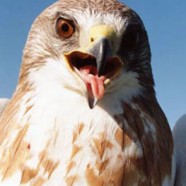
Problem/Background
The Swainson’s Hawk (Buteo swainsonii, SWHA) is listed as a species of concern by five states and the Bureau of Land Management, and as a special emphasis species by the U.S. Forest Service. Nesting population declines was reported over much of the SWHA range in the early 1990s. With no obvious reason for this decline, scientists postulated that problems along migration routes or on wintering areas were responsible. In 1995 and 1996, we monitored Swainson’s hawk distribution on and off military installations in the western U.S., where their numbers had been diminishing at an alarming rate for unknown reasons.

The Swainson’s Hawk
Approach/Objectives
Thirty Swainson’s hawks were captured and tagged with satellite-received transmitters during July, August, and September 1996, in eight locales within the western United States and Canada: California (one), Colorado (three), Idaho (six), Minnesota (two), Oregon (six), Utah (three), Arizona (two), Saskatchewan or Alberta, Canada (seven). Birds typically departed from nesting areas in mid to late September and arrived in Argentina beginning in the second week of November. By late November, 25 of the 30 Swainson’s hawks had crossed the Argentinean border and by mid-December had settled into the Pampas region of central Argentina. In January of 1996, scientists visited different areas indicated by the satellite derived location data. They counted over 4,000 dead SWHA, killed as an apparent side effect of pesticide applications to Argentinean croplands, and these scientists believed the actual mortality numbers might have exceeded 20,000. This loss represented a serious threat to the survival of the species. Biologists in Argentina gathered blood samples for chemical analyses and attempted to gather behavioral data to relate behavior and ecology to land uses, environmental contaminants, and other threats

The Swainson’s Hawk
Results/Conclusion
We learned that the catastrophic population decline resulted from the use of a toxic organophosphate pesticide, recently brought into use on the Argentinean Pampas where these hawks winter in communal roosts. Through the use of remote tracking and monitoring technology, this environmental problem was identified and, within 18 months, remedied through collaborative government and private sector management and education. Keeping this raptor off the endangered species list saved millions of federal dollars by avoiding costly large-scale research and recovery programs and related habitat management activities in North America. This application of wildlife tracking via satellite is a perfect demonstration of the unique advantage this technology can provide in the study of a wide-ranging species

Swainson's Hhawk migration map
